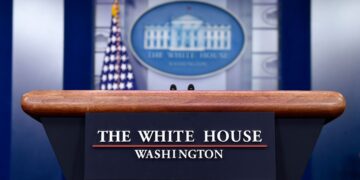By John F. Di Leo -
Does society have an obligation to educate its young?
Of course. A society can only thrive if its people know how to be citizens, how to be workers, how to be members of the community. Raised in the wild, we might produce children of the “Lord of the Flies” variety, and we know what kind of adults such children become: just look at our inner cities.
So in every election, from local to national, we are reminded of the great cause of education. “It’s for the children!” we are told, with greater emphasis, higher pitch and louder volume as Election Day nears. Any complaint about methods, any argument about spending, is turned back on the challenger as an indictment: “You just don’t care about our children!”
The illogical and vicious arguments in such campaigns are a time-honored tradition for a reason. They work.
But are they fair?
What is Society?
Our fundamental problem is actually with the primary question itself. “Does society have an obligation to educate its young?”
It’s the same problem we have with every issue: should society provide Healthcare? Housing? Security? Food? Heat in the winter? Air conditioning in the summer?
The answer is Yes, of course, society should strive to enable every citizen to attain all these things and more. The question is how best to get there, and what method is both efficacious and moral. Just because we have a desired end does not mean that the means go without saying.
Our Founding Fathers studied the question. They studied the whole of human history… when the Framers met in 1787 to form our new government, they discussed and debated the relative positives and negatives of monarchy and democracy, republic and military dictatorship, the patriarchy of Rome and the feudal system of medieval Europe. They considered what was moral to enshrine in law, and what had been proven effective when tried in the past.
And upon such study – which predated the Constitutional Convention, by the way, as these thoughtful statesmen had been considering such issues for decades – they came to a simple conclusion, one that can be summarized in a few short words:
That government that governs least, governs best.
Contrary to the attacks of the statists – the modern Left – this is not a refusal to address the needs discussed above. Rather, it is a sober recognition that when government attempts to “provide” such needs directly, it must step on other liberties that are just as important or even more so, by overtaxing the population, and exerting undo controls upon the citizenry.
We have also seen that when government attempts to provide these needs directly anyway, it invariably does at least as much damage as it helps. Consider:
- When government provides housing, the housing is overpriced and quickly degraded, so it’s a curse to its residents rather than a blessing (cf. Chicago’s Cabrini Green and Robert Taylor Homes).
- When government provides food, it costs the earth and goes to waste, invariably failing at the effort to provide nutrition to the needy (cf. the ubiquitous stories of food stamps being used for alcohol or snacks or currency, and the very recent tales of Obama–inspired school lunch menus causing practically everything to be discarded in the trash).
- When government provides healthcare, it commoditizes an art that differs from person to person, causing both a skyrocketing of costs and a plummeting of quality (cf. Great Britain’s National Health, and our own current, horrific experience with Obamacare).
- Can we rationally expect government-provided education to be any different?
For these reasons, and in anticipation of such results, our Framers recognized that while Society has obligations, the Government is not – and should not be – directly responsible for providing many of those obligations.
In fact, Government is only a small part of Society, and our Framers believed it should be the smallest part – critical, even in some things strong and empowering – but still the smallest part of Society.
Our Society is in fact a mixture of individuals, businesses, charities and other nonprofit associations, and government. Government itself can even be broken up into national, state, and local.
And even when we remind ourselves of the 10th Amendment, we tend to forget its true meaning: it’s not just that the federal government must often retreat so that state and local governments move in, it’s mostly that all governments must often retreat from the field, in recognition that the private sector can and should address the issue, rather than government at all.
So when we agree that “Society has an obligation,” we must consider what part of that obligation each component bears. Perhaps that obligation is best assigned to the government; perhaps to the churches and charities, perhaps to the business community. And perhaps it is best assigned to the individual.
As always, it is wise to take a cue from the experience of the Founding Era:
Education in the Days of our Founders
There were basically three education options in the Founding Era:
Homeschooling: Parents taught their children, either alone or in groups; they bought or borrowed books for their children to read, assigned them copying assignments and other homework, and apprenticed them to professionals such as surveyors or merchants, to learn a trade and have a natural job ready for them upon matriculation.
The Little Red Schoolhouse: Parents sent their children to a little school, run by the local church or by a local businessman. It was either funded by parish donations or the tuition charged by the entrepreneur running the school.
The Private Tutor: In a huge and expanding country, there were always rural areas that could never support a school… for these, parents could contract out with a local tutor, an entrepreneur who’d spend a few hours a week with your child, loaning him books, giving assignments. And if you were unsatisfied with your child’s progress, it was easy enough to just change tutors by signing on with a different one (compare that to the difficulty of changing your child’s school today!).
These were our options in the Founding Era.
Did they work? Well, let’s consider:
Our third president, Thomas Jefferson, author of the Declaration of Independence, was educated by private tutors. Our second president, John Adams, diplomat to England, France, and Holland before his vice-presidency and presidency, attended the local parish schools. And our very first president, George Washington, among the most successful businessmen in the country and the architect of our War of Independence, was homeschooled.
Yes, I’d say it worked.
Modern American Education
So how did we get from this effective system to the unbelievably costly system we have today?
Impatience. It really comes down to impatience.
In a growing country, there were bound to be areas where the little red school houses and private tutors didn’t show up at the exact same time as population growth needed them… there were bound to be areas where most of the people were too poor to hire even inexpensive tutors or buy books. Private funding of libraries developed, and generous parishioners funded heavily subsidized education for other parishioners’ children…
But not all at the same time, not all the same year, so there were the cries for fairness and equality of opportunity – and these certainly are reasonable cries.
So government got involved. And by the middle of the 20th century, the vast majority of children in America were attending government-run schools, which could have better biology and chemistry and physics laboratory classrooms than any private tutor or one-room schoolhouse could dream of… not to mention beautiful theaters, and huge gymnasiums, and Olympic-size swimming pools. Oh, with government dollars came incredible benefits, with which no tutor or homeschool option could compete.
And as a result, the Catholic schools and Protestant schools and Jewish schools shrank… even as the nation grew more affluent, more and more people could no longer afford to pay for private schools, not when the government schools were “already free” – paid for in our property taxes, sales taxes, and state income taxes.
Government, however, works as it always does: whatever it produces costs a lot more than it has to, and grows a lot bigger than it needs to. So the public schools have lots of administrators (the little red schoolhouse of old had none); they have lots of buses and parking lots and football stadiums and tennis courts. Nothing against any of this, of course, but it adds cost. And none these things have anything to do with education.
So perhaps to make up for that, the schools started paying teachers more. “It’s fair, they deserve to be paid better!” And for many, it’s true – there are so many wonderful teachers, amid the bad, mediocre, and burned out ones – so from the 1970s to the present we have seen an explosion of pay for teachers, from severe underpayment before to … well, they’re not all overpaid, but as a group, public school employees are certainly paid more than we can afford.
Remember, there was once a trade-off: if you become a teacher, you’ll be paid less than a normal private sector job could offer, but you’ll have a shorter workday, most days, and you’ll get summers off, and lots of vacation days and breaks, and a pension. And if you’re good, there’s such marvelous job satisfaction! For millions of teachers, such a trade-off was always worth it.
But with the modern effort to increase pay, most states didn’t take back the summer vacation or multiple holidays; we’re now trying to pay them as high a salary as the private sector pays a 40-hour-week, 50-week-a-year professional. The math for this just doesn’t work, especially in a country that has imported 20 or 30 million new residents and students in a generation, hardly any of whom can afford to contribute to these school districts’ operations as taxpayers.
And it’s no longer remotely fair to the non-teaching taxpayers who must fund this unsustainable equation.
So school districts – whether consciously or unconsciously – are bankrupting their states. It’s as simple as that.
Some states have been sensible – Wisconsin under Governor Scott Walker has been a role model for revising the laws to make public education affordable again. But other states have just kicked the can down the road for decades; Illinois, for example, has the “most underwater” teacher pension system in the country.
As the taxes climb higher and higher to fund this behemoth, the people who should be able to save the system by taking their kids out of this costly government system simply cannot do so; paying five, ten, even fifteen thousand dollars a year or more in property taxes, mostly for our schools, most of us certainly cannot pay private school tuition too.
Post hoc, ergo propter hoc. Our public school system has become the classic poster child of the vicious circle.
The Solutions of the Future
The amazing thing is, now should be the perfect time to cut costs out of K-12 education!
- With modern computing, every student has the equivalent of a physics and math lab in his hands, on a laptop computer or touchscreen, for just a few hundred dollars.
- With the advent of freely available public domain classics, students can read the Great Books on their computers, even if they’re a hundred miles from the nearest library, even if they can’t afford to put the physical books on their shelves.
- With a $50 or $75/month internet connection, and either that same laptop or a smart TV or desktop monitor, teachers can handle not just classes of 15 or 20, but 25 or 30, or even more, by talking on YouTube, Facetime, Skype, Webex or GoToMeeting.
There is simply no need to build massive multimillion dollar schools anymore… or establish school bus networks or lunch programs for them all. If a district wants it, and can afford it, they certainly have the option, but it’s no longer necessary. Technology has solved the challenge. Even the poorest child in the poorest district could get government funding for a cheap computer and an internet connection, and learn from the best teachers online even if he or she lived in an inner city tenement (yes, this is happening already, today… ever hear of Khan Academy?)
Why should kids in Chicago, New York, Detroit or Los Angeles risk their lives walking or riding a bus to the government-funded gang recruitment centers that we call inner city public schools today? They could stay home and learn in the safety of their apartments.
In fact, considering the savings to the taxpayers by such a move, government could provide far better welfare – better targeted, better spent – to help get them out of those dangerous neighborhoods sooner rather than later… if only we could pull the plug on these old-fashioned school buildings and move into the future.
But we can’t, because the existing public school system is a weight that simply cannot be turned on a dime, as much as we need it to.
Think of everything you’ve been warned about massive container ships and hundred-boxcar freight trains: the physics of the matter require advance warning before they can be stopped or turned; it’s much like that here. Everything in our system is structured to support this massive school system; the prospect of it being transformed, to be leaner and more efficient, is simply anathema to the bureaucracy, the teachers’ union, the already-deep indebtedness of every district.
Imagine a society in which our best teachers could be accessed by all students, nationwide, through youtube accounts. Imagine a society in which poor students didn’t have to risk their lives walking through gang-infested neighborhoods to get to school. Imagine a society in which students could shut their doors and give full attention to the lectures on their screens, without the distractions of spitball firing, pen flinging, even molestation and drug deals in the back of the classroom.
But this isn’t on the horizon, because it takes every penny the state can squeeze, and more, just to pay the lifetime obligations already promised to the existing staff.
Where exactly will the innovations hit first? Which states, which districts, which children will benefit first from such tools as web-based learning, absolute safety from the dangers of gang-run schools, and access to the best teachers?
Well, this much is certain: before we can move forward, we first must pay for our past and our present… and in too many states, we can’t even do that.
We need fiscal management, in our school districts, our counties, and our state capitals, to fund existing obligations without further bankrupting our citizens, so that we can again experiment, as we once did, and find the cost-effective solutions that will educate the millions who are currently left behind, undereducated and endangered by the morally and financially bankrupt system we have.
It all begins with Election Day… and the choice of school board members who think of the future, trustees who think of the children and the taxpayers, the local employers and local needs… trustees who will not be mouthpieces for the teachers’ unions and the Democratic Party. And that’s the job of the voters.
Can it be done? Certainly.
But first, we need the electorate to kick out the old guard in most of our school boards… and pick instead the people who will get us out of debt and give us a chance to move forward. No wiser investment for future generations is possible, after a century of profligate spending by teachers’ union puppets, until we first get ourselves out of hock.
Copyright 2017 John F. Di Leo
John F. Di Leo is a Chicagoland-based Customs broker, actor, and writer. His columns are found regularly in Illinois Review.
Permission is hereby granted to forward freely, provided it is uncut and the IR URL and byline are included.







